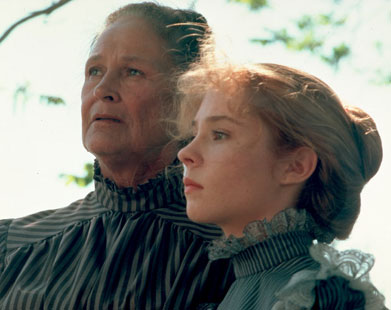
Again, these reviews are from my children's literature journal. Please don't get mad at me if I am not as gushing as many women are about Anne and her struggles. I was reading as an adult evaluator, not my romance-burdened adolscent self. Don't worry, the early books hold up well. The following site has some great images: http://officialanneofgreengables.wikia.com/wiki/Anne_Shirley
Montgomery, L. M., Anne of Green Gables
NOTE: Part of my exhaustion with this book was its extremely small font. I squinted the whole time and had to take frequent breaks. I’m not reading this edition of any of the other books.
This book opens the Green Gables series. And it is exhausting. Anne is excessively talkative and talks breathily and extravagantly. I feel every bit of Marilla’s impatience with her. Little less talk, little more action, please. Still, I could hear Anne’s voice—she is distinct as a character, as are her adoptive parents, Marilla and Matthew (who are unmarried, elderly, brother and sister), Mrs. Lynde, and others. The early part of the book is filled with pathos as we learn about Anne’s life before her adoption and see the adjustments the threesome must make to form a family. Anne bemoans her red hair, meets her “bosom friend” Diana, starts school, breaks her ankle, goes off to teacher’s college, has concerts and social events, and learns, learns, learns. All while talking. Much ground is covered, although I hope for less distance and more detail in the next books. I craved a bit of the detail that I got in the Little House series—Anne learns to bake, but bake what, and how? And what is Matthew doing out there on the farm all day? How does money and food come into their lives?
Still, this is an engaging book, with a feminist slant (sadly missing from the Little House books). Anne competes head-to-head with a boy for top scholastic honors and either ties or wins every time. She sees herself as someone who will have a working life outside the home. She doesn’t want to compromise herself. She is lively, loving, intense, driven, and wonderfully observant.
I especially liked cranky old Mrs. Lynde. She poured a little vinegar on the treacle every now and then.
This is a good book, told both directly and indirectly (through third-person accounts, letters, and implications). It brings to life a particular time in a particular place (still longing for more detail…) and is loyally Canadian. It is still fresh after lo these many years in print. What girl cannot relate to an orphan finding a home? It’s what we all wish for. There’s an inner orphan in most of us, that part of us that feels unappreciated, homeless. Onward to Avonlea…
Montgomery, L. M., Anne of Avonlea
The second book of the series is more of the same—lots of fun and pathos. Anne is growing up. She teaches school at Avonlea, gets involved in the romances of others, but still doesn’t see the role of romantic love in her own life—her relationship with Gilbert Blythe (the obvious love interest from the time Anne was ten) remains elusive and undeveloped. The last chapter of this book indicates that Anne may be awakening to the hunkiness of Gilbert. But I recall from an earlier read that it takes a few more books before Anne and Gilbert straighten out their love affair.

This book introduces the twins, Dora and Davy. At the end, Mrs. Lynde joins the household. A new neighbor, Mr. Harrison, is introduced, along with his cursing parrot. And Anne gets involved with Miss Lavender, and facilitates a romance and wedding. There are more cooking disasters (Davy lands on the pies, way too much sugar is added to the vegetables, an important platter is broken).
Anne continues engaging and sweet. She really is likable, and her inner life is fully developed. She strives to do right, but without giving up the beauty she has always seen in the world. She is as beloved to the reader as she is to the fictional residents of Avonlea.
I notice that these books were written closer to the time they occurred than some of the historical treasures on this list. That explains the lack of historical detail (although there is a bit too much in this book about how to kill chickens!) of how the people lived. The author was writing for her contemporaries, not for those a generation (or generations) removed. These books are morally instructional, but mostly they seem to be written for fun—and to encourage girls to lead a more morally and educationally exciting life.




